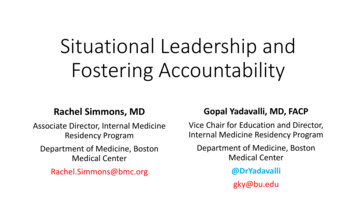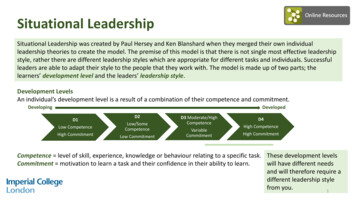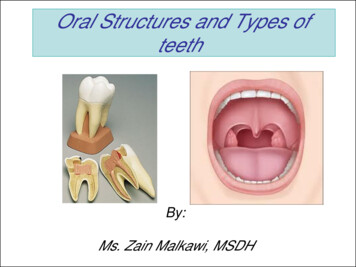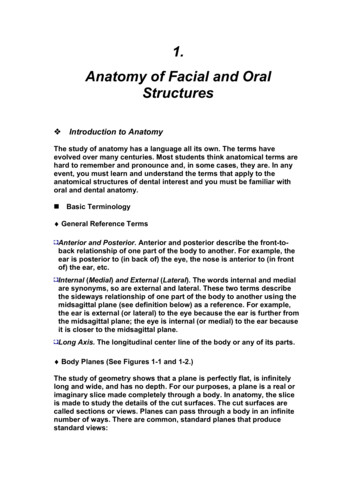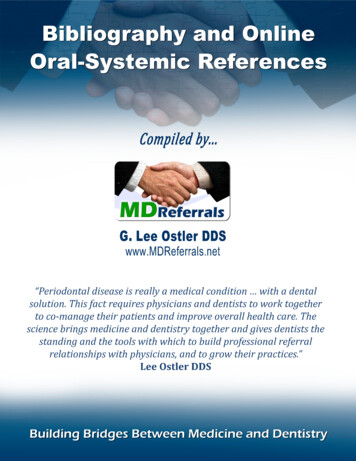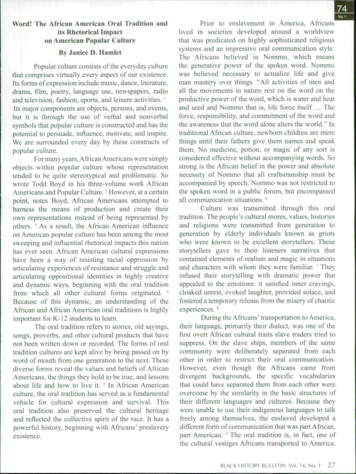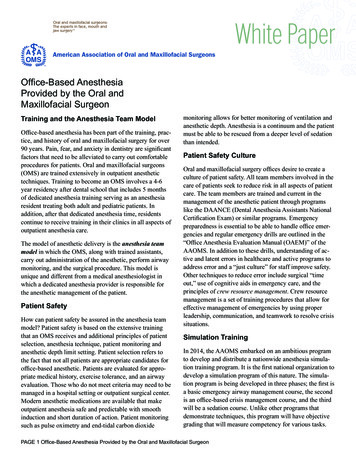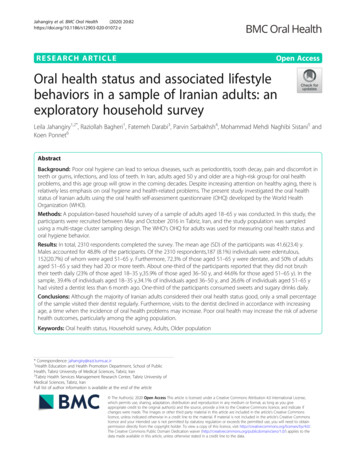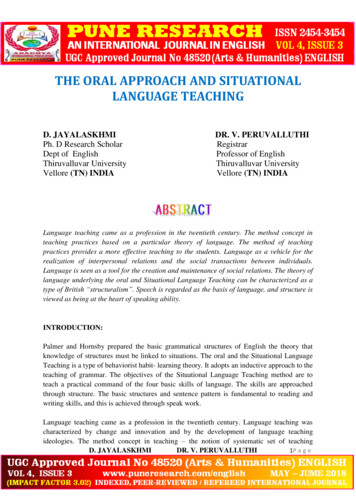
Transcription
THE ORAL APPROACH AND SITUATIONALLANGUAGE TEACHINGD. JAYALASKHMIPh. D Research ScholarDept of EnglishThiruvalluvar UniversityVellore (TN) INDIADR. V. PERUVALLUTHIRegistrarProfessor of EnglishThiruvalluvar UniversityVellore (TN) INDIALanguage teaching came as a profession in the twentieth century. The method concept inteaching practices based on a particular theory of language. The method of teachingpractices provides a more effective teaching to the students. Language as a vehicle for therealization of interpersonal relations and the social transactions between individuals.Language is seen as a tool for the creation and maintenance of social relations. The theory oflanguage underlying the oral and Situational Language Teaching can be characterized as atype of British “structuralism”. Speech is regarded as the basis of language, and structure isviewed as being at the heart of speaking ability.INTRODUCTION:Palmer and Hornsby prepared the basic grammatical structures of English the theory thatknowledge of structures must be linked to situations. The oral and the Situational LanguageTeaching is a type of behaviorist habit- learning theory. It adopts an inductive approach to theteaching of grammar. The objectives of the Situational Language Teaching method are toteach a practical command of the four basic skills of language. The skills are approachedthrough structure. The basic structures and sentence pattern is fundamental to reading andwriting skills, and this is achieved through speak work.Language teaching came as a profession in the twentieth century. Language teaching wascharacterized by change and innovation and by the development of language teachingideologies. The method concept in teaching – the notion of systematic set of teachingD. JAYALASKHMIDR. V. PERUVALLUTHI1P a g e
practices based on a particular theory of language and language learning is a powerful one.The quest for better methods was a preoccupation of many teachers and applied linguiststhroughout the twentieth century. Each method is the belief that the teaching practicesprovide a more effective and theoretically sound basis for teaching then the methods thatpreceded it.There are three different theoretical views of language and the nature of language approachesand methods in language teaching. The first is the structural view. The language is a systemof structurally related elements for the coding of meaning. The second view of language isthe functional view. The language is a vehicle for the expression of functional meaning. Thistheory emphasizes the semantic and communicative dimension rather than the grammaticalcharacteristics of language. The third view is the interactional view. Language as a vehiclefor the realization of interpersonal relations and the social transactions between individuals.Language is seen as a tool for the creation and maintenance of social relations structural 54functuional models of language provide a theoretical frame work that may motivate aparticular teaching method, such as audio Audiolingualism.Language teachers are familiar with the terms Oral Approach or Situational LanguageTeaching. The language teaching developed by British linguists from the 1930s to the 1960.The impact of the Oral Approach has been long-lasting and it has shaped the design of manytext books. Harold Palmer and A.S. Hornby are familiar with this method. They attempted todevelop a more scientific foundation for an oral approach to teaching English than the directmethod.According to Palmer, that vocabulary is one of the first aspects of foreign language learning.A second influence is the increased emphasis on reading skills as the goal of the languagestudy. Language teaching is developing classroom procedures suited to teaching basicgrammatical pattern through an oral approach. Grammar as the underlying sentence patternsof the spoken language. The main characteristic of the approach are as follows: Language teaching begins with the spoken language. Material is taught orallybefore it is presented in written form.The target language is the language of the classroom.New language points are introduced and practiced situationally.Vocabulary selection procedures are followed to ensure that an essentialgeneral service vocabulary is covered.Items of grammar are graded following the principle that simple forms shouldbe taught before complex ones.D. JAYALASKHMIDR. V. PERUVALLUTHI2P a g e
Reading and writing are introduced once a sufficient lexical and grammaticalbasis is established.The theory of learning underlying situational language teaching is a type of behavioristhabitlearning theory. It addresses primarily the processes rather that the conditions oflearning. Like the direct method, situations language teaching adopts and inductive approachto the teaching of grammar. The meaning of words or structure is not to be given throughexplanation in either the native language or the target language but is to be induced form theway the forms is used in a situation. “it we give the meaning of a new word, either bytranslation into the home language or by an equivalent in the same language , as soon as weintroduce it we weaken the impression which the word makes on the mind” (Billows. 1961:28). Explanation is therefore discouraged, and the leaner is expected to deduce the meaningof a particular structure or vocabulary item from the situation in which it is presented.Expending structure and vocabulary to new situation takes place by generalization.The leaner is expected to apply the language learned in a class room to situation outside theclassroom. This is how child language learning is believed to take place, and the sameprocesses are thought to occur in second and foreign language learning.The objectives of the situational language teaching method are to teach a practical commandof the four basic skills of language goals it shares with most methods of language teaching.But the skills are approached through structure. Accuracy in both pronunciation and grammaris regarded as crucial, and errors are to be avoided at all costs. The basic structures andsentence a pattern is fundamental to reading and writing skills, and this is achieved throughspeech work. “ Before our pupils read new structures and new vocabulary, we shall teachorally both the new structures and the new vocabulary” (Pittman, 1963: 186).Basic to the teaching of English in situational language teaching is a structural syllabus and aword list. A structural syllabus is a list of the basic structures and sentence pattens of English,arranged to the order of presentation. Structures are always taught within sentences, andvocabulary is chosen according to how well it enables sentence patterns to be taught.The learner is required simply to listen and repeat what the teacher says and to respond toquestions and commands. More active participation is encouraged. This includes learnersinitiating response and asking each other questions.In the presentation stage of the lesson, the teacher serves as a model, salting up situations inwhich the need for the target. Structure is created and then modeling the new structure forstudents to repeat. The teacher is required to be skillful manipulator using questions,D. JAYALASKHMIDR. V. PERUVALLUTHI3P a g e
communards and other cues to elicit correct sentences form the learners. During the practice,students are given more of an opportunity to use the language in less controlled situations, butthe teacher is even on the lookout the grammatical and structural errors.The teacher’s responsibilities are1. Tinning2. Oral practice to support the text book structures3. Revisions4. Adjustment to special needs of individuals.5. TestingSome activities to follow this method:1. Listening practice in which the teacher obtains his student’s attention and repeater andexample of the patterns or a word in isolation clearly, several times, probably saying it slowlyat least once.2. Choral imitation in which students all together or in large groups repeat what the teacherhas said3. Individual invitation in which the teacher asks several individual students to repeat themodel he has given in order to check their pronunciation.4. Isolation, in which the teacher isolates sounds words, or groups of words which causetrouble and goes through techniques.5. Substitution drilling in which the teacher uses cue words (words, pictures, number names,etc) to get individual students to mix the examples of the new patterns.6. Question answer drilling, in which the teacher gets one student to ask a question andanother to answer until most students in the class have practiced asking and answering thenew question form.D. JAYALASKHMIDR. V. PERUVALLUTHI4P a g e
1) Alexander, L.G. 1967.New Concept English, 4 vols, London: Longman2) Billows, F.I. 1961. The Techniques of Language Language Teaching. London: Longman.3) Byrne, D.1976. Teaching Oral English. London: Longman.4) Gatenby, E.V.1944. English as a Foreign Language. London:Longman.5) Palmer, H.E. 1923. The Oral Method of Teaching Languages. Cambidge:HefferD. JAYALASKHMIDR. V. PERUVALLUTHI5P a g e
speech work. “ Before our pupils read new structures and new vocabulary, we shall teach orally both the new structures and the new vocabulary” (Pittman, 1963: 186). Basic to the teaching of English in situational language teaching is a structural syllabus and a word list. A structural syllabus is a list of the basic structures and sentence .

